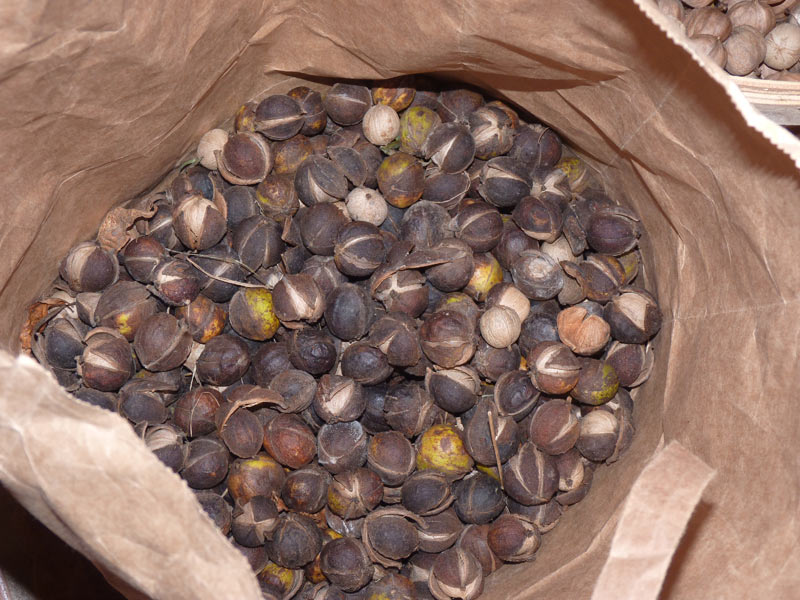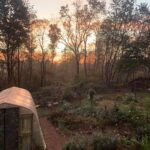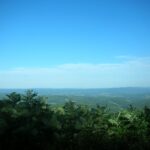
I am going to do a series of posts on trees–I started a second 3rd degree Adept project for the AODA, and its on expanding the traditional Ogham to include plants native to the Mid-west/mid-Atlantic region. This project will also take me three years, but its work well worth doing :). The first tree I want to focus on as part of this work is the Hickory tree–which is a bit of an elusive tree in terms of Western knowledge, but when we look to native American traditions, we find a wealth of information.
Physical Properties: Hickory trees typically produce a good crop of nuts every third year after they reach 30 or 40 years old (depending on the sub-species). Hickory wood is extremely tough, and was used by natives and settlers alike in the USA as a wood for axe handles and other tools (a practice that continues to this day). The Ojibway used the wood for bows due to its elasticity and strength. Hickory wood remains one of the most efficient woods in North America for burning (only Black Locust, a non-native tree, has a higher BTU). Hickory also makes an excellent charcoal (and savory smoke). In Michigan, we have a number of hickories, including red hickory, pignut hickory, shellbark hickory, and shagbark hickory.
The Doctrine of Signatures: The Doctrine of Signatures is used in traditional Western herbalism and suggests that the plant itself and its physical qualities help us understand the qualities that it helps heal. I’d like to propose, also, that we can use the doctrine of signatures to understand the magical properties of trees, especially those that are not traditional to the western magical literature, like hickory.
So let’s take a look at its physical properties and the magical lessons it might teach us:
- Patience: Hickory is very slow to grow. A typical hickory tree takes 30 or 40 more years to produce nuts. Furthermore, after you’ve waited the 30 or 40 years to see the tree produce nuts, if you’ve ever tried to get at hickory nutmeats, you’ll know its hard to get the full nutmeat out easily. Both of these qualities lend themselves hickory being associated with patience.
- Strength yet Flexibility. Hickory wood is prized and used for tools, bows, and furniture because is nearly as strong as steel but very flexible. It burns very clean and makes a long-lasting fire. Both of these qualities inherent in the tree lead to its qualities of strength and flexibility.
Traditional Western & Magical Herbalism. Very little in the traditional lore books speaks to hickory, neither traditional herbals (Wood, Grieve) or magical herbals (Greer, Beyerl). I was expecting to see something from the Hoodoo tradition, but it, also does not appear in Yronwode’s Hoodoo Herb and Root Magic. Cunningham, who I don’t always like to trust, has something about the tree focusing on law/keeping away the law, but I have no idea where he derived his information. I’m not seeing it repeated anywhere else, and its not consistent with the doctrine of signatures nor the native lore.

Native American Lore/Myths: Native American mythology sheds some substantial light on the magic of the hickory. The Seneca discuss hickory trees at length in their mythology (as described in Seneca Indian Myths, collected by Jeremiah Curtin). The hickory is featured prominently in these myths is connected with the dead and bringing the dead to life. In “Okteondo and his Uncle”, “Man-Eater and his Brother,” “Owl and His Jealous Wife,” “Uncle and Nephew” and “Hodadeio and His Sister” the bones of the dead are placed before a great hickory tree (usually after being eaten by cannibals) and, typically, the living person who placed the bones pushes against the hickory and shouts “Rise up or the tree will fall on you” the dead rise up and become living again. In “Hodadieo and his Sister”, after Hodadieo’s sister rises up from the dead under threat of being crushed by the hickory, Hodadieo throws a hickory nut to the west and commands the other nuts to follow, which they do, and all the nuts end up in the family’s stores for the winter. In other tales, the hickory is made into canoes (Wishakon and His Friend Visit Plethoak) for travel.
Native Herbal Uses: The sap of the Shagbark hickory was used by the Iroquois as a sweetener and, when mixed with bear grease, a bug repellent. Shagbark’s young shoots/leaves were used by the Ojibway for headaches. The Potawatomi boiled the bark and applied it to tender muscles for arthritis pain.
My Hickory Nut Experiences: I have been having a difficult time this year, as I mentioned in an earlier post about blight and the magical garden. I have found myself really, really drawn to the hickory tree during the last few months. A friend and I have been gathering an abundance of hickory nuts this year–more than either of us have ever seen (see photos, lol)! We probably have over 100 lbs of hickory nuts we are now shelling. One night, despite the fact that I had lots of other things to do, I found myself shelling hickory nuts for a long while. It was a peaceful, relaxing activity, and the more I shelled, the more I was at peace. A few days later, I went back down to this amazing pignut hickory tree at the corner of my property, where I had been gathering the nuts. I sat with my back against the tree (this is a practice described in John Michael Greer’s Celtic Golden Dawn curriculum, which I’m working through) and did a tree meditation. It was incredible. I watched the sun set, and I felt the hickory tree healing me and calming me. I’ve also been making a “four sacred trees” brew using hickory nuts and some other trees–I’ll blog about that shortly in my next post :).




I practice aikido, a Japanese martial art that sometimes includes the jo, a short staff – the best ones that I’ve seen are generally made of hickory.
Erik, Aikido is a really fascinating martial art–I’ve studied it a bit. Interesting that hickory is used for the jo!
Thank you for doing this work to explore the hickory. Some of my favorite trees aren’t included in the Ogham and I’ll be interested in your work on native trees.
Karen, what are your favorite trees? I’m going to cover maple, cedar, sassafrass, sycamore, hemlock, chestnut, and beech for sure. I’m still figuring out the others. Some, like Ash, are going to need to have some revisions for this landscape.
I grew up in maple syrup country, so the maple is iconic for me. And I have a special place in my heart for the sad chestnut. There are many little chestnut trees locally and I even found one that bears nuts–but alas, they’re sterile as it needs another mature tree to cross-pollinate. Hemlock and sassafrass would be good additions. I’m quite fond of our native red and black spruce, and the larch.
P.S. White pine, of course! I forgot it wasn’t included in the Ogham.
Love white pine! 🙂
North American Cottonwood Poplar, Hawthorn, swamp white oak, swamp chestnut oak
Good trees 🙂
Hi there. This a great project to work on -and something I’ve heard talk of from a few other people who are interested in Druidry. I do think it is important for us North Americans to develop/add to the ogham in our own ways because some trees aren’t as prevalent from the Ogham, or other trees from North America are all around and we can develop deeper relationships with them. Being an Ohioan the Buckeye would be included in my own native Ogham. Of course it has wider range -there are some interesting hoodoo uses for the Buckeye.
I haven’t actually had experiences with the Buckeye tree…I’ve lived in Michigan, PA, and Indiana (all surrounding Ohio) but never Ohio! I’ll have to look up Buckeye in my hoodoo books :).
But yes, I agree–we need to develop relationships with the trees in this landscape, understand their lore, and how they can help us.
I was taking my morning walk, not in nature but down the road, when I happened to kick a nut that was still in its husk. Right way the husk flew off the nut. Curious, I picked it up and at first I thought that maybe it was a pecan, mainly because of the husk. I also knew that you cannot assume anything. The funny was, when I was a child, my father was stationed in Ft. Sill, Oklahoma, and behind our house we had a pecan tree. The nut that I picked up this morning and the nuts I picked up and gave to my Mom was not the same. This was an odd circle with what looked like a small stem on top. It also has a very pleasant woody nutty smell to it, which again remind me of pecans.
Now I had to look it up, and found out it was a form of hickory nut – pignut hickory nut.
I want to thank you for this blog/article. It is very illuminating.
I’ve been told by others (such as my 80 year old neighbor I learn so much from) that pignut hickory aren’t good eating. I disagree. They aren’t as good as say, shagbark hickory, but when that’s the only hickory you’ve got, its still pretty good. I especially think its good for making the hickory brew :). I have a pignut hickory in my yard and I eat it often. Thank you for your comment 🙂
I definitely agree about our landscape and trees. We have wonderful trees with many qualities, but when looking to the European landscape and lore, the trees and plants are different. Do you find the best medicinal and herbal lore comes from the Native Americans? Any book suggestions on a Native Indian “field guide” type book? I have long been fascinated by the plants. I have slowly been learning about herbs. Your website taught me about “poison Hemlock” which looks like queen annes lace or the wild carrot. Guess we were lucky the ones we touched were never the poison hemlock.
This is a really excellant resource, thank you so much for posting
I found a shagbark hickory this year that produced a massive amount of nuts. I will maintain that there is no tree nut so delicious as that of the shagbark hickory. I invested in a practically industrial nutcracker (for Hickory and Black Walnut) and sat patiently cracking on various days…it was so worth the effort. I thank the tree every time I pass by it.
I totally agree! I adore the shagbark hickory tree and honor it :). Have you tried making the nut milk? Sooooo good!
I beg to differ about the hottest or highest BTU of Black Locust versus other species but….the Osage Orange burns hotter than any….North American tree. It is also thee most rot resistant and…insect resistant of any continental species. It burns with nearly the equivalent BTU’s as bituminous (soft) coal. It WILL warp a steel wood burner. Best used in a well-maintained fireplace or cast iron wood burner.
Now you know the rest of the story.
Smiling Fox
~(X)~
Thanks for sharing! I don’t actually have any Osage Orange around here, so that explains why I don’t know that tree! Such good info–thanks! 🙂
Last night I dreamed that my grandfather and I were in a rural setting and he showed me a tree that he said was a cottonwood tree and he explained that the leaf could sometimes grow unusually long so I began to look around the area for a cottonwood tree. I found a tree with a longish leaf and reached to pluck a nut from it. The nut pinched my fingers but I continued to examine it. This tree wasn’t a cottonwood, but a hickory tree. (At this point I should say that I’ve never identified either tree in waking life, but the dream hickory leaf and nut were positively identified by research this morning.)
I read that Native American culture considered the cottonwood tree a tree of protection and resurrection. And, as you note, the hickory tree represents patience and strength.
I’m presently meditating on both these qualities because this dream occurred the night after a major family tragedy.
Grandfather. Protection/resurrection. Patience/Strength.
Hi Almiramay, wow, this sounds like a very powerful dream and vision, especially given the tragedy you are experiencing. It sounds like you are doing the right thing in meditating on it. Maybe if you can, find a hickory tree and sit with the hickory. Even in the winter, shagbark hickory is pretty easy to identify. Blessings to you!